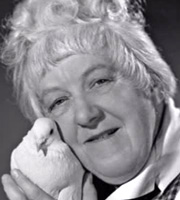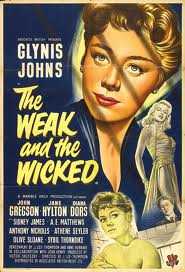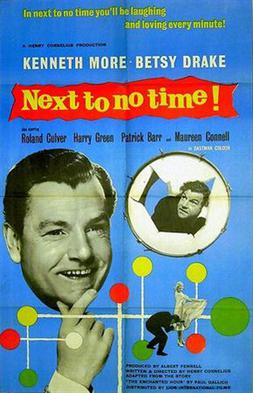
Kenneth Gilbert More, CBE was an English film and stage actor.

Miss Robin Hood is a 1952 British comedy film directed by John Guillermin, and starring Margaret Rutherford and Richard Hearne. Other actors involved include Dora Bryan, James Robertson Justice, Peter Jones, Sid James, Reg Varney, Kenneth Connor and Michael Medwin. The film features a variety of unusual camera work such as unexpected extreme close-ups and fast motion sequences.

John Gregson, born as Harold Thomas Gregson, was an English actor of stage, television and film, with 40 credited film roles. He was best known for his crime drama and comedy roles.

Doctor in the House is a 1954 British comedy film directed by Ralph Thomas and produced by Betty Box. The screenplay, by Nicholas Phipps, Richard Gordon and Ronald Wilkinson, is based on the 1952 novel by Gordon, and follows a group of students through medical school.

Henry Kendall AFC, was an English stage and film actor, theatre director and revue artiste.

Lady Godiva Rides Again is a 1951 British comedy film starring Pauline Stroud, George Cole and Bernadette O'Farrell, with British stars in supporting roles or making cameo appearances. It concerns a small-town English girl who wins a local beauty contest by appearing as Lady Godiva, then decides to pursue a higher profile in a national beauty pageant and as an actress.
John Gervase Dighton was a British playwright and screenwriter.

Jean Kent, born Joan Mildred Field was an English film and television actress.

The Weak and the Wicked is a 1954 British drama film directed by J. Lee Thompson based on the autobiographical novel Who Lie in Gaol by his wife, Joan Henry, starring Glynis Johns and Diana Dors.

The Good Die Young is a 1954 British crime film directed by Lewis Gilbert and starring Laurence Harvey, Gloria Grahame, Joan Collins, Stanley Baker, Richard Basehart and John Ireland. It was made by Remus Films from a screenplay based on the 1953 novel of the same name by Richard Macaulay. It tells the story of four men in London with no criminal past whose marriages and finances are collapsing and, meeting in a pub, are tempted to redeem their situations by a robbery.

Cosh Boy is a 1953 British film noir based on an original play by Bruce Walker. It was directed by Lewis Gilbert and featured James Kenney and Joan Collins. It was made at Riverside Studios in Hammersmith.

Susan Shaw was an English actress.

Next to No Time, also known as Next to No Time!, is a 1958 British colour comedy film written and directed by Henry Cornelius and starring Kenneth More, Betsy Drake, John Laurie, Sid James and Irene Handl. It was based on Paul Gallico's short story The Enchanted Hour. It was the last feature film completed by Cornelius before his death in 1958. The film concerns an underconfident engineer who is helped by the advice of a ship's barman.

The Hard Way is a 1943 Warner Bros. musical drama film starring Ida Lupino, Dennis Morgan, and Joan Leslie. Directed by Vincent Sherman, it is based on a story by Irwin Shaw which was reportedly based on Ginger Rogers' relationship with her first husband Jack Pepper and her mother Lela.

Doctor in Love is a 1960 British comedy film, the fourth of the seven films in the Doctor series, directed by Ralph Thomas and starring James Robertson Justice and Michael Craig. It was the first film in the series not to feature Dirk Bogarde, although he did return for the next film in the series Doctor in Distress. It was loosely based on the 1957 novel of the same title by Richard Gordon.

As Long as They're Happy is a 1955 British musical comedy film directed by J. Lee Thompson and starring Jack Buchanan, Susan Stephen and Diana Dors. It is based on the 1953 play of the same name by Vernon Sylvaine. It was shot in Eastmancolor at Pinewood Studios near London with sets designed by the art director Michael Stringer.

Keep It Clean is a 1956 British black-and-white comedy film directed by David Paltenghi and starring Ronald Shiner and Joan Sims.

The Feminine Touch is a 1956 colour British drama film directed by Pat Jackson and starring George Baker, Belinda Lee and Delphi Lawrence. In 1957 it was released as A Lamp Is Heavy in Canada, and The Gentle Touch in the United States.
The Hot Potato Boys is a 1963 Australian television play.

Shameful Behavior? is a 1926 American silent romantic comedy film directed by Albert H. Kelley and starring Edith Roberts, Richard Tucker and Martha Mattox. It is based on a 1910 short story of the same name by Marie Belloc Lowndes.


















